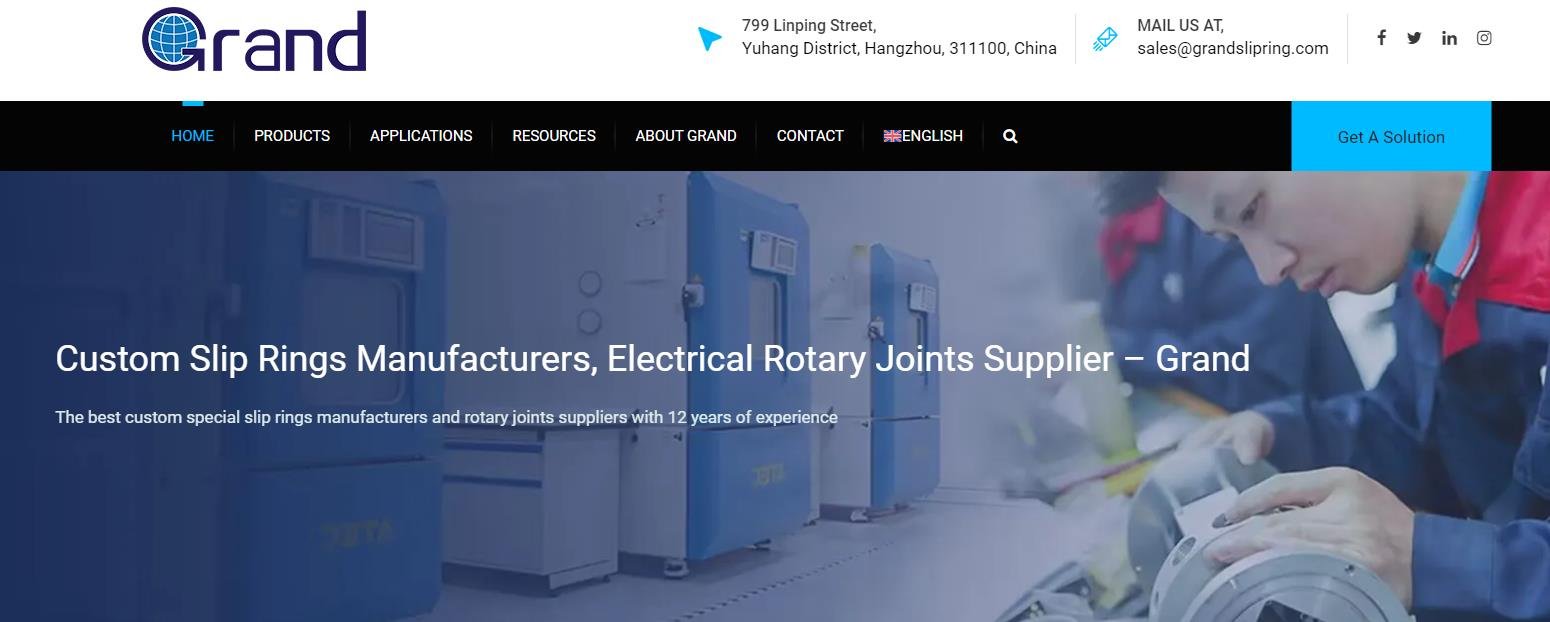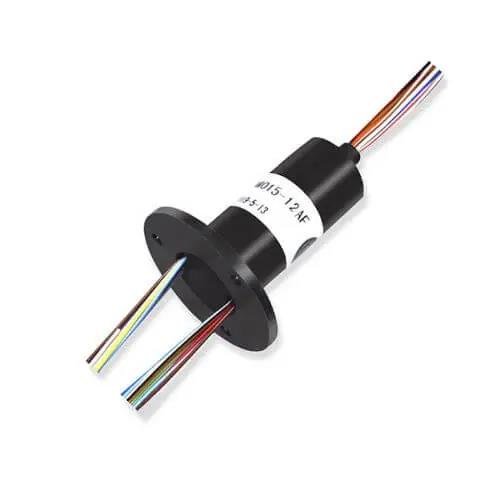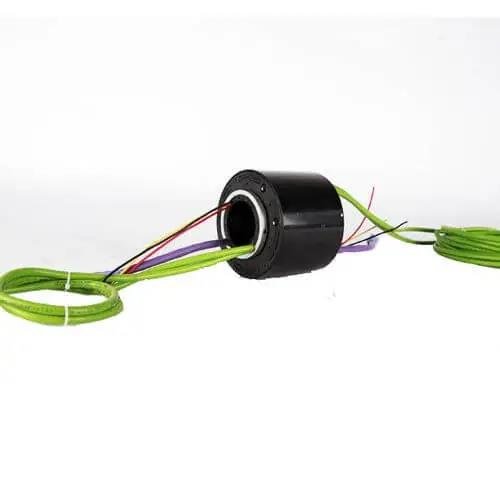Slip ring technology is crucial in various applications that require the transmission of power and signals between stationary and rotating components. These electromechanical devices ensure continuous electrical connections, enabling seamless operation in systems like wind turbines, medical imaging equipment, and industrial machinery. The significance of slip rings lies in their ability to maintain reliable communication and power transfer without the hassle of tangled wires or frequent maintenance. Custom slip rings further enhance this technology by addressing specific electrical, mechanical, and environmental requirements, providing tailored solutions that ensure optimal performance and durability in specialized applications.

Explanation of Contact Technologies
Slip ring technology is essential for transferring power and signals between stationary and rotating parts in various applications. The contact technology used in slip rings is crucial for their performance, reliability, and longevity. Different contact materials and designs offer distinct advantages and are chosen based on specific application requirements. This section provides a detailed explanation of the three primary contact technologies used in slip rings: metal brushes, fiber brushes, and precious metal contacts.
Metal Brushes vs. Fiber Brushes vs. Precious Metal Contacts
Metal Brushes
Metal brushes are the traditional contact method used in slip rings. These brushes are typically made of conductive materials such as graphite, copper, or a combination of metals.
Benefits:
Durability: Metal brushes are robust and can handle high current loads, making them suitable for heavy-duty applications.
Cost-Effective: They are relatively inexpensive to manufacture and maintain, providing a cost-effective solution for many applications.
High Power Capacity: Metal brushes can transmit high levels of power, making them ideal for applications that require substantial electrical power transfer.
Applications:
Industrial Machinery: Used in equipment that demands high power transmission and can tolerate some maintenance.
Wind Turbines: Suitable for transferring power from the rotating blades to the stationary grid.
Heavy Equipment: Ideal for cranes, mining machinery, and other heavy-duty equipment.
Drawbacks:
Wear and Tear: Metal brushes can wear down over time, leading to increased maintenance and potential downtime.
Higher Electrical Noise: These brushes can generate more electrical noise, which may interfere with signal quality in sensitive applications.
Fiber Brushes
Fiber brushes are made from numerous strands of fine conductive fibers. This design offers multiple contact points between the rotating and stationary parts.
Benefits:
Low Contact Resistance: Fiber brushes provide a large number of contact points, reducing overall contact resistance and improving electrical performance.
Reduced Wear: The flexible nature of fiber brushes allows for even distribution of wear, extending the lifespan of the slip ring.
Low Electrical Noise: Fiber brushes generate less electrical noise compared to metal brushes, ensuring higher signal integrity.
Applications:
Medical Devices: Used in applications like MRI and CT scanners where low electrical noise and high signal integrity are critical.
High-Speed Data Transmission: Ideal for applications requiring precise and reliable data transfer, such as communication systems.
Robotics: Used in robotic arms and automated systems that demand continuous operation with minimal maintenance.
Drawbacks:
Higher Cost: Fiber brushes are generally more expensive to produce than metal brushes.
Limited Power Capacity: While excellent for signal transmission, fiber brushes may not handle as high power loads as metal brushes.
Precious Metal Contacts
Precious metal contacts, such as gold-on-gold or silver-on-silver contacts, offer superior performance in terms of conductivity and corrosion resistance.
Benefits:
Excellent Conductivity: Precious metals like gold and silver have high electrical conductivity, ensuring efficient power and signal transmission.
Corrosion Resistance: These metals are highly resistant to corrosion and oxidation, maintaining their performance over time.
Low Contact Resistance: The use of precious metals results in minimal contact resistance, enhancing signal quality and reducing power loss.
Applications:
Aerospace: Used in satellites and other aerospace equipment where reliability and performance are paramount.
High-Precision Instruments: Ideal for scientific instruments and other applications that require precise and reliable signal transmission.
Capsule Slip Ring: Often used in compact, high-performance slip rings like capsule slip rings, which need to provide reliable operation in confined spaces.

Drawbacks:
Cost: Precious metal contacts are more expensive than other contact types due to the high cost of materials.
Wear: While resistant to corrosion, precious metals can still wear over time, particularly in high-load applications.
Benefits and Applications of Each Contact Technology
Each contact technology offers specific benefits that make them suitable for different applications:
Metal Brushes:
Durability and High Power Capacity: Ideal for heavy-duty applications that require robust and cost-effective solutions.
Industrial and Heavy Equipment: Perfect for applications where high power transfer is necessary, and some maintenance is acceptable.
Fiber Brushes:
Low Electrical Noise and Reduced Wear: Suitable for applications that require precise signal transmission and minimal maintenance.
Medical Devices and Robotics: Best for environments where high signal integrity and continuous operation are crucial.
Precious Metal Contacts:
Excellent Conductivity and Corrosion Resistance: Perfect for applications that demand high performance and reliability.
Aerospace and High-Precision Instruments: Ideal for applications where the highest levels of reliability and signal quality are required.
The choice of contact technology in slip rings significantly impacts their performance, reliability, and suitability for different applications. Metal brushes offer durability and cost-effectiveness for heavy-duty applications, fiber brushes provide low electrical noise and extended lifespan for precision devices, and precious metal contacts deliver superior conductivity and corrosion resistance for high-performance applications. Whether used in a capsule slip ring for compact and demanding environments or in industrial machinery for heavy-duty power transfer, selecting the right contact technology is essential for ensuring optimal performance and longevity of slip rings.
Importance of Low Electrical Noise and High Signal Quality
Factors Contributing to Electrical Noise
Electrical noise is an undesirable disturbance that affects the signal quality in electrical systems. It is crucial to minimize electrical noise in slip rings to ensure efficient and reliable transmission of power and data. Several factors contribute to electrical noise in slip rings, including:
- Contact Resistance:
Variations in contact resistance can generate electrical noise. Poor or inconsistent contact between the brushes and rings can lead to fluctuating resistance, causing intermittent electrical noise and signal distortion.
- Friction and Wear:
Mechanical friction between the rotating and stationary components can produce electrical noise. As the brushes wear down, the contact surface becomes uneven, leading to increased noise and signal degradation.
- Material Properties:
The materials used in the construction of the slip ring contacts can also affect electrical noise. Inferior or inappropriate materials may not provide stable and reliable contacts, resulting in higher noise levels.
- Environmental Factors:
External factors such as temperature, humidity, and contamination can impact the performance of slip rings. Moisture and dust can interfere with the contacts, causing noise and reducing signal quality.
- Electrical Interference:
Electromagnetic interference (EMI) from other electrical devices and systems can induce noise in slip ring circuits. Proper shielding and grounding are necessary to mitigate these effects.
Importance of Signal Integrity in Critical Applications
Signal integrity is vital in applications where accurate and reliable data transmission is crucial. In critical applications such as medical imaging, aerospace, and communication systems, maintaining high signal quality is essential for operational efficiency and safety.
- Medical Imaging:
In MRI and CT scanners, high signal integrity ensures that the imaging data is accurate and free from artifacts. Any noise or signal degradation can compromise the quality of the images, leading to incorrect diagnoses and treatment plans.
- Aerospace:
Aerospace systems rely on precise data transmission for navigation, control, and communication. Poor signal quality can result in miscommunication, system errors, and potentially catastrophic failures.
- Industrial Automation:
In industrial automation, accurate signal transmission is necessary for the precise control of machinery and processes. Noise and signal loss can lead to operational inefficiencies, equipment malfunctions, and increased downtime.
- Ethernet Slip Rings:
Ethernet slip rings, used for high-speed data transmission, require excellent signal integrity to ensure seamless and reliable communication. These slip rings are often used in applications where data accuracy and speed are critical, such as robotics, surveillance systems, and data acquisition systems.
Role of Advanced Contact Technologies in Reducing Noise
Advanced contact technologies play a significant role in reducing electrical noise and improving signal quality in slip rings. The development of innovative contact materials and designs has greatly enhanced the performance and reliability of slip rings.
- Gold-On-Gold Contacts:
Gold-on-gold contacts are highly effective in reducing electrical noise due to their excellent conductivity and resistance to oxidation. Gold provides a stable and low-resistance contact surface, minimizing fluctuations in resistance and reducing noise. This technology is particularly beneficial in applications requiring high signal integrity, such as medical imaging and aerospace systems.
- Fiber Brush Contacts:
Fiber brush contacts consist of numerous fine conductive fibers that provide multiple contact points. This design ensures consistent and stable electrical connections, reducing noise and enhancing signal quality. Fiber brushes also have lower friction and wear, further contributing to reduced noise levels. These contacts are ideal for high-speed data transmission applications, including ethernet slip rings.

- Composite Materials:
The use of composite materials in slip ring contacts can enhance their performance by providing better wear resistance and reducing friction. These materials can maintain stable contact surfaces, ensuring consistent signal transmission with minimal noise.
- Shielding and Grounding:
Proper shielding and grounding techniques are essential for minimizing electromagnetic interference (EMI). Advanced slip rings incorporate effective shielding to protect against external noise sources, ensuring clean and reliable signal transmission.
Maintaining low electrical noise and high signal quality is critical in applications that require precise and reliable data transmission. Factors such as contact resistance, friction, material properties, environmental conditions, and electromagnetic interference can contribute to electrical noise. In critical applications like medical imaging, aerospace, industrial automation, and high-speed data transmission using ethernet slip rings, high signal integrity is paramount for operational efficiency and safety. Advanced contact technologies, including gold-on-gold contacts, fiber brush contacts, and composite materials, play a crucial role in reducing noise and enhancing signal quality. By incorporating these innovations, slip rings can deliver superior performance and reliability, ensuring seamless power and data transmission in various high-tech applications.
Material Considerations for Durability and Performance
The choice of materials in slip ring construction is crucial for ensuring their durability and performance. Slip rings are used in a wide range of applications, from industrial machinery to advanced medical equipment, and each application has specific requirements that must be met. This section explores the importance of selecting the right materials for slip rings, focusing on contact materials, housing materials, and insulation materials.
Contact Materials: Gold, Silver, etc.
Gold Contacts:
Gold is often the preferred choice for contact materials in slip rings due to its excellent electrical conductivity and resistance to corrosion. Gold contacts provide several benefits:
- High Conductivity: Gold has one of the highest levels of electrical conductivity, which ensures efficient power and signal transmission. This is particularly important in applications requiring high precision and low electrical noise, such as medical imaging equipment and high-speed data communication systems.
- Corrosion Resistance: Gold does not tarnish or oxidize, which means it maintains its conductivity and performance over time, even in harsh environments. This resistance to corrosion makes gold contacts ideal for use in outdoor applications and other challenging environments.
- Low Contact Resistance: The low contact resistance of gold ensures minimal power loss and high signal integrity, which is crucial for applications that demand reliable and accurate data transmission.
Silver Contacts:
Silver is another popular choice for contact materials due to its high conductivity and relatively lower cost compared to gold. Silver contacts offer the following benefits:
- Excellent Conductivity: Silver has slightly higher electrical conductivity than gold, making it suitable for applications that require efficient power transmission.
- Cost-Effective: Silver is less expensive than gold, providing a cost-effective solution for many applications without compromising on performance.
- Good Wear Resistance: Silver contacts can withstand mechanical wear, which enhances the durability and longevity of slip rings.
Other Materials:
Other contact materials, such as copper and graphite, are also used in specific applications. Copper offers good conductivity and is cost-effective, while graphite provides excellent wear resistance and is used in high-wear applications.
Housing Materials: Anodized Aluminum, Stainless Steel
Anodized Aluminum:
Anodized aluminum is commonly used for slip ring housings due to its lightweight, durability, and corrosion resistance. The anodizing process enhances the natural oxide layer on aluminum, providing several benefits:
- Corrosion Resistance: The anodized layer protects the aluminum from corrosion, making it suitable for use in harsh environments, including marine and outdoor applications.
- Increased Hardness: Anodizing increases the surface hardness of aluminum, improving its wear resistance and durability. This makes anodized aluminum housings ideal for applications that involve mechanical stress and frequent use.
- Thermal Performance: Anodized aluminum has good thermal conductivity, which helps dissipate heat generated during operation, preventing overheating and ensuring optimal performance.
Stainless Steel:
Stainless steel is another widely used material for slip ring housings, offering superior strength and resistance to corrosion and wear:
- Durability: Stainless steel housings provide excellent mechanical strength, making them suitable for heavy-duty applications that require robust construction.
- Corrosion Resistance: Stainless steel is highly resistant to rust and corrosion, ensuring long-lasting performance even in challenging environments.
- Aesthetic Appeal: Stainless steel offers a sleek, professional appearance, which is beneficial for applications where aesthetics are important, such as medical devices and high-end equipment.
Insulation Materials: Teflon, Advanced Polymers
Teflon:
Teflon (PTFE) is a high-performance insulation material used in slip rings due to its excellent dielectric properties and thermal stability:
- Dielectric Properties: Teflon has a high dielectric strength, which ensures effective insulation and prevents electrical faults.
- Thermal Stability: Teflon can withstand a wide range of temperatures, making it suitable for applications that operate under extreme temperature conditions.
- Chemical Resistance: Teflon is resistant to most chemicals, ensuring long-lasting performance in corrosive environments.
Advanced Polymers:
Advanced polymers, such as silicone and polyimide, are also used for insulation in slip rings, offering several advantages:
- Flexibility: Advanced polymers provide flexibility, which is crucial for applications that involve movement and mechanical stress.
- Thermal and Chemical Resistance: These materials can withstand high temperatures and resist chemical degradation, ensuring reliable performance in harsh environments.
- Durability: Advanced polymers offer excellent durability, enhancing the overall lifespan of the slip ring.
Selecting the right materials for slip rings is essential for ensuring their durability and performance. Gold and silver contacts provide excellent conductivity and resistance to wear and corrosion, making them ideal for high-precision applications. Anodized aluminum and stainless steel housings offer robust protection against environmental factors, while Teflon and advanced polymers ensure effective insulation and thermal stability. By carefully choosing the appropriate materials, slip rings can deliver reliable and efficient performance in a wide range of applications, from industrial automation to advanced medical equipment. Whether it’s ensuring high signal integrity in ethernet slip rings or providing durable performance in heavy-duty industrial machinery, the right materials make all the difference.












